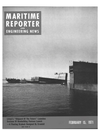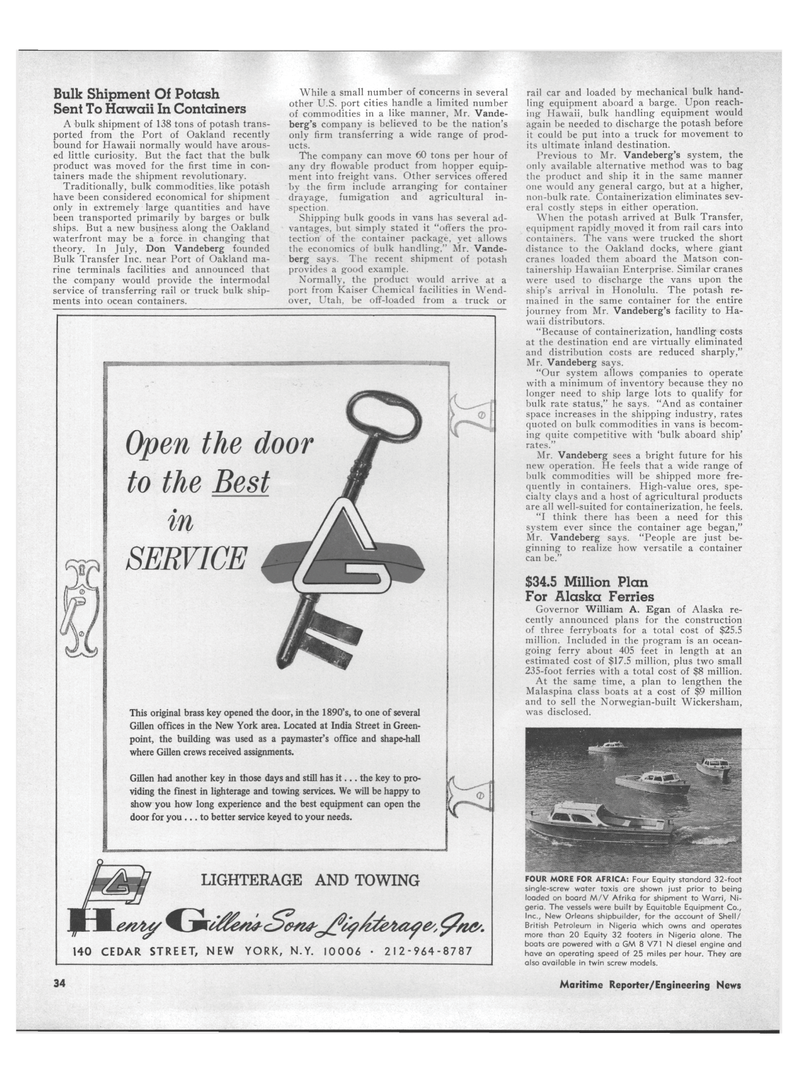
Page 30: of Maritime Reporter Magazine (February 15, 1971)
Read this page in Pdf, Flash or Html5 edition of February 15, 1971 Maritime Reporter Magazine
Bulk Shipment Of Potash
Sent To Hawaii In Containers
A bulk shipment of 138 tons of potash trans- ported from the Port of Oakland recently bound for Hawaii normally would have arous- ed little curiosity. But the fact that the bulk product was moved for the first time in con- tainers made the shipment revolutionary.
Traditionally, bulk commodities like potash have been considered economical for shipment only in extremely large quantities and have been transported primarily by barges or bulk ships. But a new business along the Oakland waterfront may be a force in changing that theory. In July, Don Vandeberg founded
Bulk Transfer Inc. near Port of Oakland ma- rine terminals facilities and announced that the company would provide the intermodal service of transferring rail or truck bulk ship- ments into ocean containers.
While a small number of concerns in several other U.S. port cities handle a limited number of commodities in a like manner, Mr. Vande- berg's company is believed to be the nation's only firm transferring a wide range of prod- ucts.
The company can move 60 tons per hour of any dry flowable product from hopper equip- ment into freight vans. Other services offered by the firm include arranging for container drayage, fumigation and agricultural in- spection
Shipping bulk goods in vans has several ad- vantages, but simply stated it "offers the pro- tection of the container package, yet allows the economics of bulk handling." Mr. Vande- berg says. The recent shipment of potash provides a good example.
Normally, the product would arrive at a port from Kaiser Chemical facilities in Wend- over, Utah, be off-loaded from a truck or rail car and loaded by mechanical bulk hand- ling equipment aboard a barge. Upon reach- ing Hawaii, bulk handling equipment would again be needed to discharge the potash before it could be put into a truck for movement to its ultimate inland destination.
Previous to Mr. Vandeberg's system, the only available alternative method was to bag the product and ship it in the same manner one would any general cargo, but at a higher, non-bulk rate. Containerization eliminates sev- eral costly steps in either operation.
When the potash arrived at Bulk Transfer, equipment rapidly moved it from rail cars into containers. The vans were trucked the short distance to the Oakland docks, where giant cranes loaded them aboard the Matson con- tainership Hawaiian Enterprise. Similar cranes were used to discharge the vans upon the ship's arrival in Honolulu. The potash re- mained in the same container for the entire journey from Mr. Vandeberg's facility to Ha- waii distributors. "Because of containerization, handling costs at the destination end are virtually eliminated and distribution costs are reduced sharply,"
Mr. Vandeberg says. "Our system allows companies to operate with a minimum of inventory because they no longer need to ship large lots to qualify for bulk rate status," he says. "And as container space increases in the shipping industry, rates quoted on bulk commodities in vans is becom- ing quite competitive with 'bulk aboard ship' rates."
Mr. Vandeberg sees a bright future for his new operation. He feels that a wide range of bulk commodities will be shipped more fre- quently in containers. High-value ores, spe- cialty clays and a host of agricultural products are all well-suited for containerization, he feels. "I think there has been a need for this system ever since the container age began,"
Mr. Vandeberg says. "People are just be- ginning to realize how versatile a container can be." $34.5 Million Plan
For Alaska Ferries
Governor William A. Egan of Alaska re- cently announced plans for the construction of three ferryboats for a total cost of $25.5 million. Included in the program is an ocean- going ferry about 405 feet in length at an estimated cost of $17.5 million, plus two small 235-foot ferries with a total cost of $8 million.
At the same time, a plan to lengthen the
Malaspina class boats at a cost of $9 million and to sell the Norwegian-built Wickersham, was disclosed.
FOUR MORE FOR AFRICA: Four Equity standard 32-foot single-screw water taxis are shown just prior to being loaded on board M/V Afrika for shipment to Warri, Ni- geria. The vessels were built by Equitable Equipment Co.,
Inc., New Orleans shipbuilder, for the account of Shell/
British Petroleum in Nigeria which owns and operates more than 20 Equity 32 footers in Nigeria alone. The boats are powered with a GM 8 V71 N diesel engine and have an operating speed of 25 miles per hour. They are also available in twin screw models.
Open the door to the Best in
SERVICE
This original brass key opened the door, in the 1890's, to one of several
Gillen offices in the New York area. Located at India Street in Green- point, the building was used as a paymaster's office and shape-hall where Gillen crews received assignments.
Gillen had another key in those days and still has it... the key to pro- viding the finest in lighterage and towing services. We will be happy to show you how long experience and the best equipment can open the door for you ... to better service keyed to your needs.
M
LIGHTERAGE AND TOWING 140 CEDAR STREET, NEW YORK, N.Y. 10006 • 212-964-8787 34 Maritime Reporter/Engineering News

 29
29

 31
31
